您好,登录后才能下订单哦!
这篇文章主要介绍了Python基础之高级变量类型的示例分析,具有一定借鉴价值,感兴趣的朋友可以参考下,希望大家阅读完这篇文章之后大有收获,下面让小编带着大家一起了解一下。
列表
元组
字典
字符串
公共方法
变量高级
Python 中数据类型可以分为 数字型 和 非数字型
数字型
主要用于科学计算,例如:平面场问题、波动问题、电感电容等问题
真 True 非 0 数 —— 非零即真
假 False 0
整型 (int)
浮点型(float)
布尔型(bool)
复数型 (complex)
非数字型
字符串
列表
元组
字典
在 Python 中,所有 非数字型变量 都支持以下特点:
都是一个 序列 sequence,也可以理解为 容器
取值 []
遍历 for in
计算长度、最大/最小值、比较、删除
链接 + 和 重复 *
切片
List(列表) 是 Python 中使用 最频繁 的数据类型,在其他语言中通常叫做 数组
专门用于存储 一串 信息
列表用 [] 定义,数据 之间使用 , 分隔
列表的 索引 从 0 开始
索引 就是数据在 列表 中的位置编号,索引 又可以被称为 下标
注意:从列表中取值时,如果 超出索引范围,程序会报错
name_list = ["zhangsan", "lisi", "wangwu"]
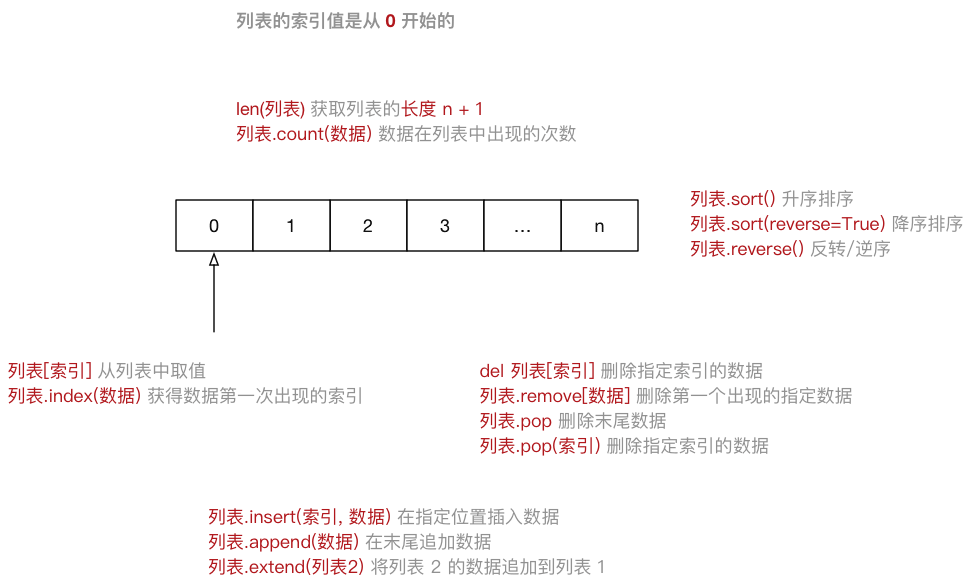
在 ipython3 中定义一个 列表,例如:name_list = []
输入 name_list. 按下 TAB 键,ipython 会提示 列表 能够使用的 方法 如下:
In [1]: name_list. name_list.append name_list.count name_list.insert name_list.reverse name_list.clear name_list.extend name_list.pop name_list.sort name_list.copy name_list.index name_list.remove

| | | 列表.append(数据) | 在末尾追加数据
| | | 列表.extend(列表2) | 将列表2 的数据追加到列表 |
| 2 | 修改 | 列表[索引] = 数据 | 修改指定索引的数据 |
| 3 | 删除 | del 列表[索引] | 删除指定索引的数据 |
| | | 列表.remove[数据] | 删除第一个出现的指定数据 |
| | | 列表.pop | 删除末尾数据 |
| | | 列表.pop(索引) | 删除指定索引数据 |
| | | 列表.clear | 清空列表 |
| 4 | 统计 | len(列表) | 列表长度 |
| | | 列表.count(数据) | 数据在列表中出现的次数 |
| 5 | 排序 | 列表.sort() | 升序排序 |
| | | 列表.sort(reverse=True) | 降序排序 |
| | | 列表.reverse() | 逆序、反转 |
del 关键字(科普)
使用 del 关键字(delete) 同样可以删除列表中元素
del 关键字本质上是用来 将一个变量从内存中删除的
如果使用 del 关键字将变量从内存中删除,后续的代码就不能再使用这个变量了
del name_list[1]
在日常开发中,要从列表删除数据,建议 使用列表提供的方法
关键字、函数和方法(科普)
关键字 是 Python 内置的、具有特殊意义的标识符
In [1]: import keyword In [2]: print(keyword.kwlist) In [3]: print(len(keyword.kwlist))
关键字后面不需要使用括号
函数 封装了独立功能,可以直接调用
函数名(参数)
函数需要死记硬背
方法 和函数类似,同样是封装了独立的功能
方法 需要通过 对象 来调用,表示针对这个 对象 要做的操作
对象.方法名(参数)
在变量后面输入 .,然后选择针对这个变量要执行的操作,记忆起来比函数要简单很多
遍历 就是 从头到尾 依次 从 列表 中获取数据
在 循环体内部 针对 每一个元素,执行相同的操作
在 Python 中为了提高列表的遍历效率,专门提供的 迭代 iteration 遍历
使用 for 就能够实现迭代遍历
# for 循环内部使用的变量 in 列表 for name in name_list: 循环内部针对列表元素进行操作 print(name)

尽管 Python 的 列表 中可以 存储不同类型的数据
但是在开发中,更多的应用场景是
列表 存储相同类型的数据
通过 迭代遍历,在循环体内部,针对列表中的每一项元素,执行相同的操作
Tuple(元组)与列表类似,不同之处在于元组的 元素不能修改
元组 表示多个元素组成的序列
元组 在 Python 开发中,有特定的应用场景
用于存储 一串 信息,数据 之间使用 , 分隔
元组用 () 定义
元组的 索引 从 0 开始
索引 就是数据在 元组 中的位置编号
info_tuple = ("zhangsan", 18, 1.75)创建空元组
info_tuple = ()
元组中 只包含一个元素 时,需要 在元素后面添加逗号
info_tuple = (50, )
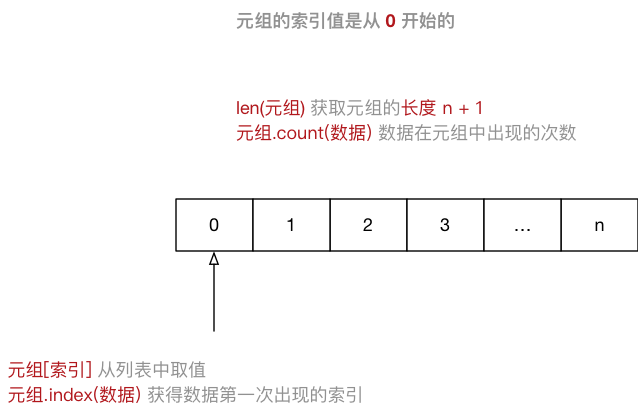
在 ipython3 中定义一个 元组,例如:info = ()
输入 info. 按下 TAB 键,ipython 会提示 元组 能够使用的函数如下:
info.count info.index
有关 元组 的 常用操作 可以参照上图练习
取值 就是从 元组 中获取存储在指定位置的数据
遍历 就是 从头到尾 依次 从 元组 中获取数据
# for 循环内部使用的变量 in 元组 for item in info: 循环内部针对元组元素进行操作 print(item)
在 Python 中,可以使用 for 循环遍历所有非数字型类型的变量:列表、元组、字典 以及 字符串
提示:在实际开发中,除非 能够确认元组中的数据类型,否则针对元组的循环遍历需求并不是很多
尽管可以使用 for in 遍历 元组
但是在开发中,更多的应用场景是:
有关 函数的参数 和 返回值,在后续 函数高级 给大家介绍
函数的 参数 和 返回值,一个函数可以接收 任意多个参数,或者 一次返回多个数据
格式字符串,格式化字符串后面的 () 本质上就是一个元组
让列表不可以被修改,以保护数据安全
info = ("zhangsan", 18)
print("%s 的年龄是 %d" % info)元组和列表之间的转换
使用 list 函数可以把元组转换成列表
list(元组)
使用 tuple 函数可以把列表转换成元组
tuple(列表)
dictionary(字典) 是 除列表以外 Python 之中 最灵活 的数据类型
字典同样可以用来 存储多个数据
通常用于存储 描述一个 物体 的相关信息
和列表的区别
列表 是 有序 的对象集合
字典 是 无序 的对象集合
字典用 {} 定义
字典使用 键值对 存储数据,键值对之间使用 , 分隔
键 key 是索引
值 value 是数据
键 和 值 之间使用 : 分隔
键必须是唯一的
值 可以取任何数据类型,但 键 只能使用 字符串、数字或 元组
xiaoming = {"name": "小明",
"age": 18,
"gender": True,
"height": 1.75}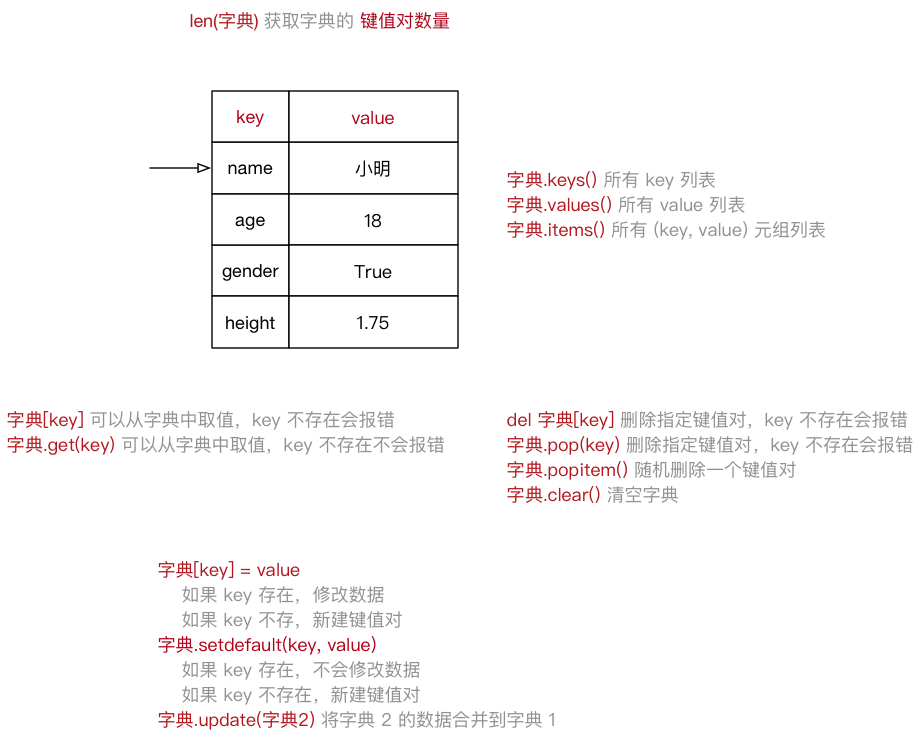
在 ipython3 中定义一个 字典,例如:xiaoming = {}
输入 xiaoming. 按下 TAB 键,ipython 会提示 字典 能够使用的函数如下:
In [1]: xiaoming. xiaoming.clear xiaoming.items xiaoming.setdefault xiaoming.copy xiaoming.keys xiaoming.update xiaoming.fromkeys xiaoming.pop xiaoming.values xiaoming.get xiaoming.popitem
有关 字典 的 常用操作 可以参照上图练习
遍历 就是 依次 从 字典 中获取所有键值对
# for 循环内部使用的 `key 的变量` in 字典
for k in xiaoming:
print("%s: %s" % (k, xiaoming[k]))提示:在实际开发中,由于字典中每一个键值对保存数据的类型是不同的,所以针对字典的循环遍历需求并不是很多
尽管可以使用 for in 遍历 字典
但是在开发中,更多的应用场景是:
使用 多个键值对,存储 描述一个 物体 的相关信息 —— 描述更复杂的数据信息
将 多个字典 放在 一个列表 中,再进行遍历,在循环体内部针对每一个字典进行 相同的处理
card_list = [{"name": "张三",
"qq": "12345",
"phone": "110"},
{"name": "李四",
"qq": "54321",
"phone": "10086"}
]字符串 就是 一串字符,是编程语言中表示文本的数据类型
在 Python 中可以使用 一对双引号 " 或者 一对单引号 ' 定义一个字符串
如果字符串内部需要使用 ",可以使用 ' 定义字符串
如果字符串内部需要使用 ',可以使用 " 定义字符串
虽然可以使用 " 或者 ' 做字符串的转义,但是在实际开发中:
可以使用 索引 获取一个字符串中 指定位置的字符,索引计数从 0 开始
也可以使用 for 循环遍历 字符串中每一个字符
大多数编程语言都是用 " 来定义字符串
string = "Hello Python" for c in string: print(c)

在 ipython3 中定义一个 字符串,例如:hello_str = “”
输入 hello_str. 按下 TAB 键,ipython 会提示 字符串 能够使用的 方法 如下:
In [1]: hello_str. hello_str.capitalize hello_str.isidentifier hello_str.rindex hello_str.casefold hello_str.islower hello_str.rjust hello_str.center hello_str.isnumeric hello_str.rpartition hello_str.count hello_str.isprintable hello_str.rsplit hello_str.encode hello_str.isspace hello_str.rstrip hello_str.endswith hello_str.istitle hello_str.split hello_str.expandtabs hello_str.isupper hello_str.splitlines hello_str.find hello_str.join hello_str.startswith hello_str.format hello_str.ljust hello_str.strip hello_str.format_map hello_str.lower hello_str.swapcase hello_str.index hello_str.lstrip hello_str.title hello_str.isalnum hello_str.maketrans hello_str.translate hello_str.isalpha hello_str.partition hello_str.upper hello_str.isdecimal hello_str.replace hello_str.zfill hello_str.isdigit hello_str.rfind
提示:正是因为 python 内置提供的方法足够多,才使得在开发时,能够针对字符串进行更加灵活的操作!应对更多的开发需求!
判断类型 - 9
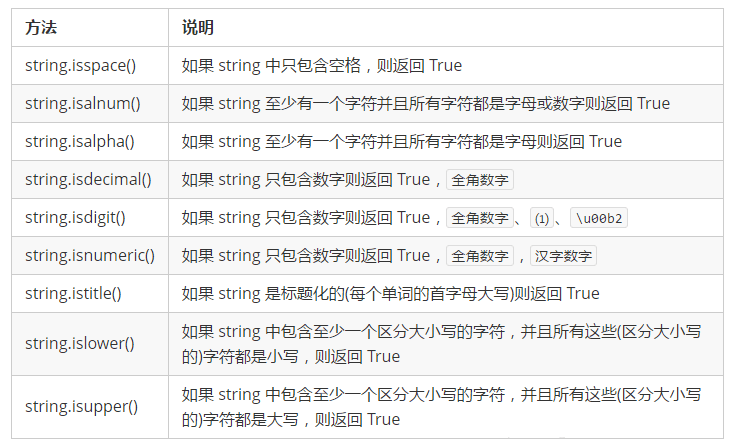
查找和替换 - 7
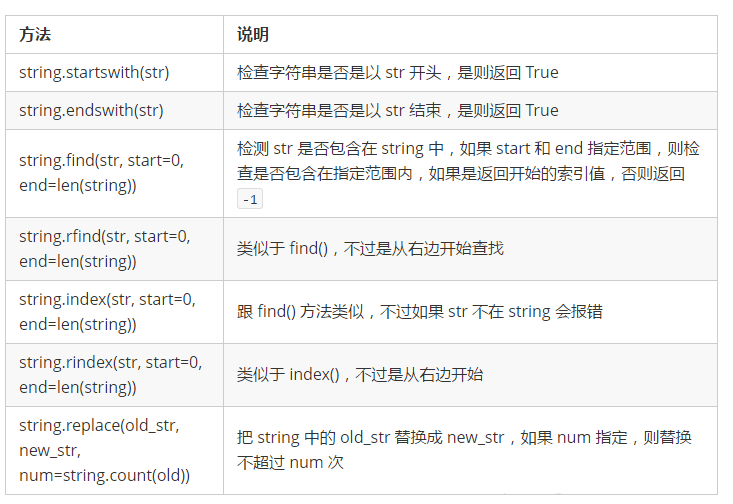
大小写转换 - 5
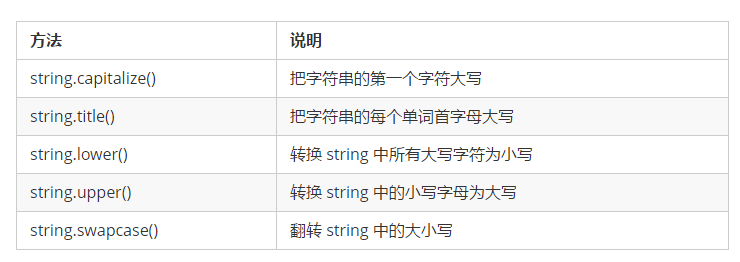
文本对齐 - 3

去除空白字符 - 3

拆分和连接 - 5
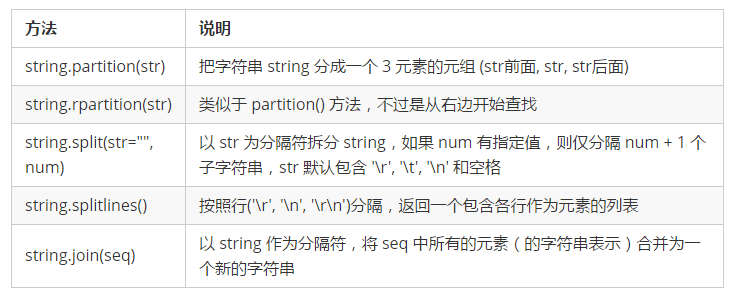
切片 方法适用于 字符串、列表、元组
切片 使用 索引值 来限定范围,从一个大的 字符串 中 切出 小的 字符串
列表 和 元组 都是 有序 的集合,都能够 通过索引值 获取到对应的数据
字典 是一个 无序 的集合,是使用 键值对 保存数据
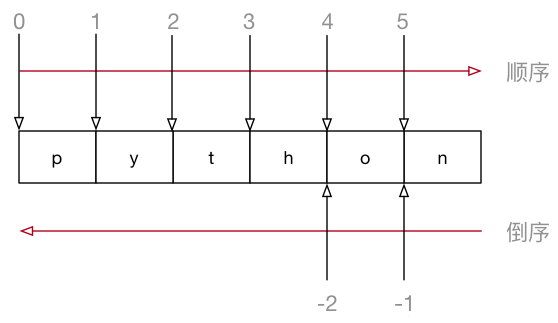
字符串[开始索引:结束索引:步长]
注意:
指定的区间属于 左闭右开 型 [开始索引, 结束索引) => 开始索引 >= 范围 < 结束索引
从 起始 位开始,到 结束位的前一位 结束(不包含结束位本身)
从头开始,开始索引 数字可以省略,冒号不能省略
到末尾结束,结束索引 数字可以省略,冒号不能省略
步长默认为 1,如果连续切片,数字和冒号都可以省略
索引的顺序和倒序
在 Python 中不仅支持 顺序索引,同时还支持 倒序索引
所谓倒序索引就是 从右向左 计算索引
最右边的索引值是 -1,依次递减
演练需求
截取从 2 ~ 5 位置 的字符串
截取从 2 ~ 末尾 的字符串
截取从 开始 ~ 5 位置 的字符串
截取完整的字符串
从开始位置,每隔一个字符截取字符串
从索引 1 开始,每隔一个取一个
截取从 2 ~ 末尾 - 1 的字符串
截取字符串末尾两个字符
字符串的逆序(面试题)
答案
num_str = "0123456789" # 1. 截取从 2 ~ 5 位置 的字符串 print(num_str[2:6]) # 2. 截取从 2 ~ `末尾` 的字符串 print(num_str[2:]) # 3. 截取从 `开始` ~ 5 位置 的字符串 print(num_str[:6]) # 4. 截取完整的字符串 print(num_str[:]) # 5. 从开始位置,每隔一个字符截取字符串 print(num_str[::2]) # 6. 从索引 1 开始,每隔一个取一个 print(num_str[1::2]) # 倒序切片 # -1 表示倒数第一个字符 print(num_str[-1]) # 7. 截取从 2 ~ `末尾 - 1` 的字符串 print(num_str[2:-1]) # 8. 截取字符串末尾两个字符 print(num_str[-2:]) # 9. 字符串的逆序(面试题) print(num_str[::-1])
Python 包含了以下内置函数: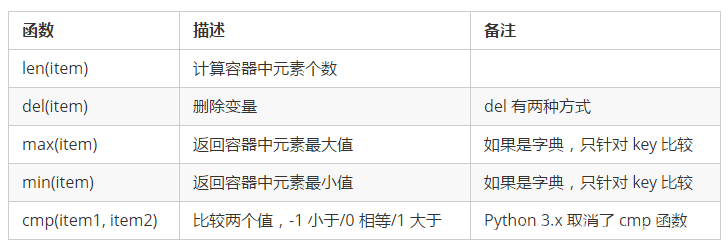
注意
字符串 比较符合以下规则: “0” < “A” < “a”

切片 使用 索引值 来限定范围,从一个大的 字符串 中 切出 小的 字符串
列表 和 元组 都是 有序 的集合,都能够 通过索引值 获取到对应的数据
字典 是一个 无序 的集合,是使用 键值对 保存数据
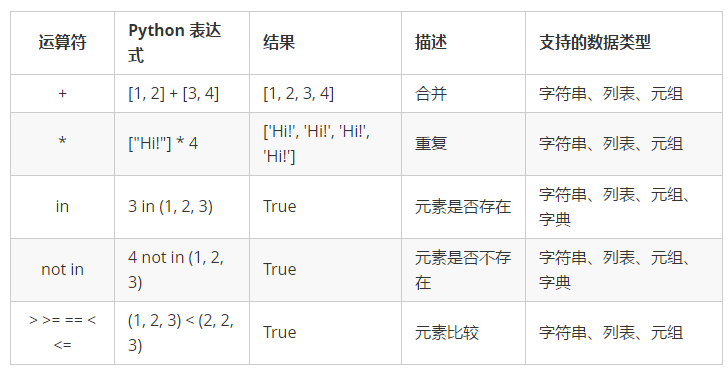
注意
in 在对 字典 操作时,判断的是 字典的键
in 和 not in 被称为 成员运算符
成员运算符
成员运算符用于 测试 序列中是否包含指定的 成员
注意:在对 字典 操作时,判断的是 字典的键
在 Python 中完整的 for 循环 的语法如下:
for 变量 in 集合: 循环体代码 else: 没有通过 break 退出循环,循环结束后,会执行的代码
应用场景
在 迭代遍历 嵌套的数据类型时,例如 一个列表包含了多个字典
需求:要判断 某一个字典中 是否存在 指定的 值
如果 存在,提示并且退出循环
如果 不存在,在 循环整体结束 后,希望 得到一个统一的提示
students = [
{"name": "阿土",
"age": 20,
"gender": True,
"height": 1.7,
"weight": 75.0},
{"name": "小美",
"age": 19,
"gender": False,
"height": 1.6,
"weight": 45.0},
]
find_name = "阿土"
for stu_dict in students:
print(stu_dict)
# 判断当前遍历的字典中姓名是否为find_name
if stu_dict["name"] == find_name:
print("找到了")
# 如果已经找到,直接退出循环,就不需要再对后续的数据进行比较
break
else:
print("没有找到")
print("循环结束")感谢你能够认真阅读完这篇文章,希望小编分享的“Python基础之高级变量类型的示例分析”这篇文章对大家有帮助,同时也希望大家多多支持亿速云,关注亿速云行业资讯频道,更多相关知识等着你来学习!
免责声明:本站发布的内容(图片、视频和文字)以原创、转载和分享为主,文章观点不代表本网站立场,如果涉及侵权请联系站长邮箱:is@yisu.com进行举报,并提供相关证据,一经查实,将立刻删除涉嫌侵权内容。